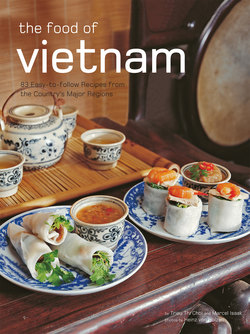Читать книгу Food of Vietnam - Trieu Thi Choi - Страница 6
На сайте Литреса книга снята с продажи.
ОглавлениеThe Imperial Cuisine
Hue, situated on the banks of the tranquil Perfume River, is the third most visited Vietnamese city after Saigon and Hanoi Once an important seat of learning and culture, as well as the imperial seat for nearly 150 years, it is slowly being rediscovered. This rather sleepy place is also the very city which once inspired the creation of most sophisticated Vietnamese cuisine, and took vegetarian cuisine to even greater heights than those reached by masterful Chinese chefs.
Hue traditionally served as a cultural, educational and religious center; it is the site of the country's most important Buddhist monasteries and temples. It was also the political capital of Vietnam, under the thirteen emperors of the Nguyen Dynasty Major tourist attractions such as the Imperial Palace and the emperors' tombs still suggest a time of great affluence. Emperor Tu Duc (1848-1883), for example, whose expansive tomb reflects his once-opulent lifestyle, is said to have demanded that his morning tea be made only from the drops of water collected by his servants from lotus leaves on the lake within the Imperial City.
Emperor Tu Duc was a notoriously finicky eater, who demanded food that was markedly different from that eaten by commoners. Since Hue lacked the agricultural diversity, the imperial kitchens were required to show an enormous amount of ingenuity—refining ordinary dishes until they became something truly special, so that eating could be viewed as art. ritual and sensory pleasure at the same time Tea-drinking was also elevated to a ceremony laden with intellectual meaning and aesthetic significance.
A typical imperial banquet today would include a dozen dishes, such as a fragrant, peppery chicken soup with lotus seeds (sup ga), crisp, golden brown spring rolls (nem ran), delicate rice flour patties stuffed with minced shrimp (banh Hue), grilled pork in rice paper (thit nuong) served with peanut sauce, delicious crab claws stuffed with pork (cua phich bot), and the famous minced shrimp wrapped around sugar cane (cha tom lui mia), known in the south as chao tom. Main dishes might include fish grilled in banana leaf (ca nuong la chuoi), pungent beef in wild betel leaves (bo la lot), rice with vegetables (com Hue), gently sautéed shrimp with mushrooms (tom xao hanh nam), and finally the glutinous rice dessert (phu the), literally translates as husband-and-wife cake.
These dishes are actually variations of those served in other parts of Vietnam, and the ingredients may be simple vegetables, eggs or fish, rather than exotic sea delicacies or the best cuts of meat What sets these dishes apart is the sophisticated cooking techniques and the presentation For example, the favorite chao tom seems so simple you would never guess the complexity of its preparation. The tiny shrimp are carefully shelled before marinating in nuoc mam. After washing, they are pounded to a thick paste, and mix with egg white, onion, garlic, sugar and pepper. The mixture is pounded again with a touch of pork fat, and finally wrapped around sugar cane sticks and grilled.
Appearance was very important, not only in the use of color and the arrangement on the plate, but also in the manner of serving. Rice, for example, might have been draped with a generous omelet coat, or cooked inside a lotus leaf and further enhanced with lotus seeds. Chefs also experimented with unusual ingredients such as green banana and unripe figs, banana blossoms and green corn, which until then had been considered unpalatable.
Portions were delicate, with perhaps dozens of dishes served in the course of one meal. Emperor Tu Duc was said to order 50 different dishes every meal, prepared by 50 different cooks and served by 50 different servants. If it was possible to reduce the size of a cake or a bun, it was done. Banh khoai, for example, is a smaller version of the banh xeo so popular in the south. Even the vegetables mixed with rice are chopped into the smallest pieces possible.
All these requirements naturally increased the length of preparation time, with the result that the number of cooks and kitchen staff reached unprecedented heights—a luxury which perfectly befitted the privileged life of an emperor.
The most talented proponents of imperial cuisine today are virtually all women, each of them descended by some route or other from imperial households. Skills were painstakingly passed down in extended families, with young cooks-to-be encouraged to first observe an experienced cook before being invited to try their hand at actual preparation.
Due to its size and relatively small population, Hue today is not a culinary mecca compared with Ho Chi Minh City or Hanoi. There is, however, a renewed interest in the cuisine of Hue, and a number of modern Vietnamese chefs have made it their mission to turn the simple art of cooking into something extraordinary, and restore imperial cuisine to its former glory.
The Citadel, or former imperial palace, in Hue.
New life is being restored to many elegant French colonial buildings.
